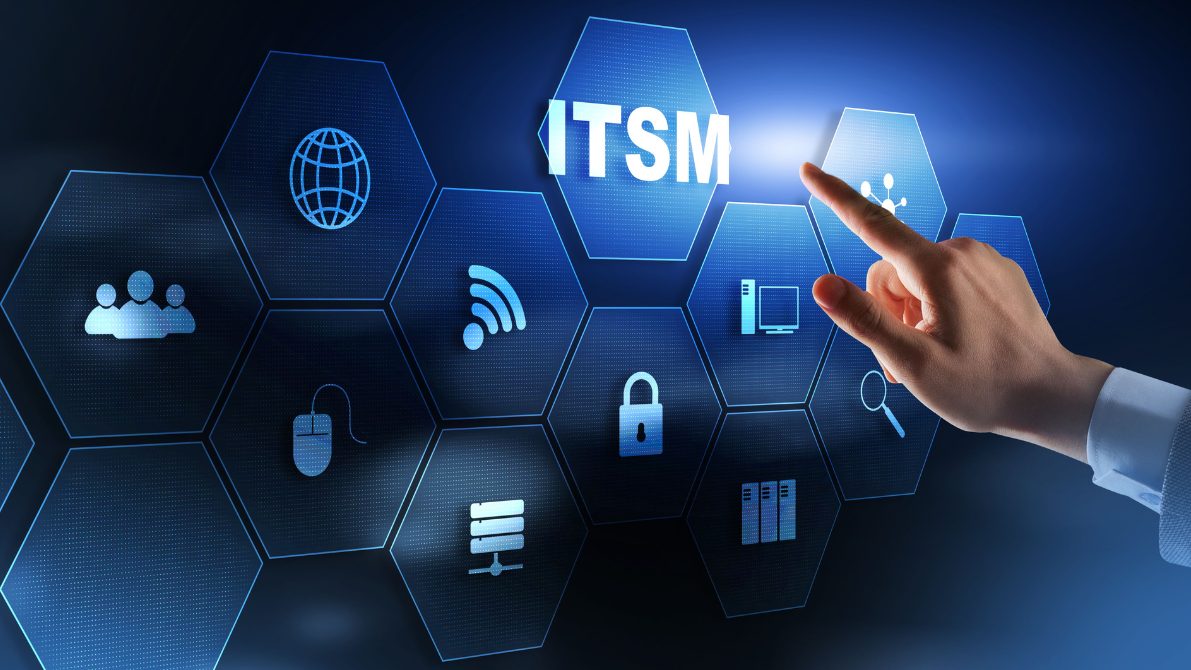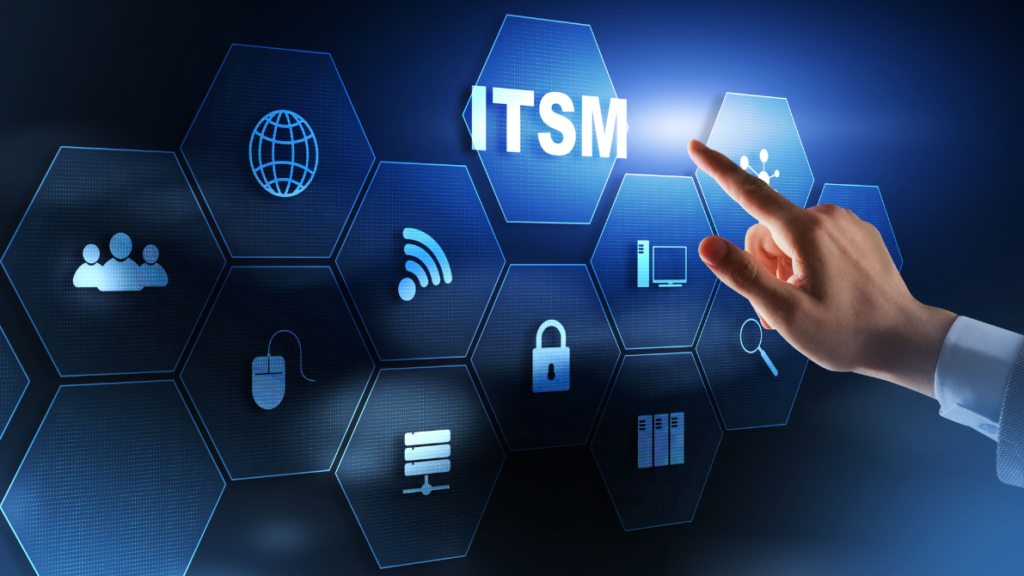IT Service Management Solutions for Improved IT Operations

IT Service Management Solutions for Improved IT Operations
Today, the role of technology in businesses is more important than ever. It’s key for IT teams to manage IT services effectively for customers, employees, and shareholders. The best way to do this is by using IT service management (ITSM) solutions. Ever thought about what makes the top ITSM platforms stand out?

IT service management, or ITSM, is the way IT teams handle providing IT services from start to finish. This means everything they do to plan, make, deliver, and support these services. The idea behind ITSM is that IT works like a service. These teams look after all the tech used in a company, from laptops to important software, aiming to make IT services better for everyone.
Key Takeaways
- ITIL 4 introduces 34 ITSM practices to create a holistic vision for IT service delivery.
- The service desk software is a crucial foundation for a robust ITSM solution.
- Jira Service Management offers an easy-to-use self-service portal, team collaboration, and flexibility for diverse IT processes.
- Following the ITIL approach can help adapt to ongoing transformations and scale IT services accordingly.
- Successful IT teams develop unique ITSM practices aligned with customer needs by drawing from frameworks like ITIL.
Understanding IT Service Management (ITSM)
ITSM stands for IT Service Management. It’s a way to handle IT services from start to end. It covers everything from planning to support for users, customers, and others. ITSM highlights running IT as a service. This means focusing on user needs and aligning tech with business goals.
What is ITSM?
ITSM sets out rules, methods, and steps for providing IT services. It ensures that IT services meet business needs and helps tech support the goals of the organization it serves. The scope of ITSM includes creating and supporting IT services.
ITSM vs. ITIL vs. DevOps
ITSM covers all IT services, and ITIL is a key ITSM approach. ITIL offers best practices for managing IT services. Meanwhile, DevOps aims to boost collaboration and quicken IT service delivery. It joins software development with IT operations.
Why is ITSM Important?
ITSM matters because it connects IT with business goals. It improves service quality and the efficiency of IT work. By following ITSM, companies become more agile and save money. They handle IT problems before they can harm them. They also better meet rules, please customers, and serve their workforce.

| Benefit for Business | Benefit for the IT Department | Benefits for Users/Employees |
|---|---|---|
| Increased Agility | Improved Productivity | Improved IT Support |
| Reduced Costs | Increased User Satisfaction | Omni-channel Experience |
| Fewer IT Problems | Better Process Scaling | Clearer Roles and Responsibilities |
| Easy Compliance | Faster Incident Detection and Response | Improved Business Alignment |
| Better Service |
Benefits of Implementing IT Service Management Solutions
Using IT service management (ITSM) solutions brings lots of plusses for different groups. Businesses, IT teams, and users all win. They see better efficiency, more work done, and happier customers by using ITSM’s ways and tools.
Benefits for Businesses
Operational Efficiency: Companies get more out of what they have by using ITSM well. They get down to the nitty-gritty of work, keep IT tools in check, and make the most of them all. Cost Reduction: With ITSM’s help, they cut down on doing things by hand. This lets their people do more important work, saves on IT costs, and makes things smoother. Risk Mitigation: ITSM makes changes less scary by setting rules processes, and better talk to avoid messes.
Benefits for IT Departments
Productivity: ITSM tools make IT teams work better and show how well they’re doing. They fix problems faster and make things run smoother. Visibility & Insights: ITSM lets teams and bosses see more clearly what’s being done. It spots snags, points to what can be made better, and shows where to use robots to help. Communication: ITSM cuts out the blah between teams, bosses, and clients. This means working together better, being clearer, and solving problems faster.
Benefits for Employees and End-Users
Customer Experience: ITSM makes clients happier by serving them better and fixing problems faster. Streamlined Support: IT teams using ITSM give better and quicker help by setting up a special desk for all IT stuff. Self-Service Productivity: Companies get better by letting workers and clients help themselves more. This saves time and makes everyone smile more.

Key ITSM Processes and Practices
Effective IT Service Management (ITSM) involves several essential processes. These processes allow companies to offer reliable, effective and customer-focused IT services. Important ITSM processes include incident, change, problem, and knowledge management.
Incident Management
The incident management process aims to quickly restore regular service after issues or outages. It involves recording, prioritizing, and solving incidents to limit their effect. This helps companies lower downtime, raise user satisfaction, and improve their overall IT service quality.
Change Management
Change management oversees planning, coordinating, and executing IT changes. It ensures that changes happen safely, manages risks, and lessens their impact on business as usual. Change management allows companies to meet new business needs while keeping IT services stable and reliable.
Problem Management
Problem management focuses on fixing the core causes of incidents to prevent them from happening again. It examines incident patterns, identifies causes, and applies fixes to solve the real issues. Strong problem management can boost IT service quality, lower incident numbers, and make systems more stable.
Knowledge Management
Knowledge management means creating, sharing, and using company knowledge to make better decisions, ease processes, and improve IT service delivery. It includes maintaining a knowledge base, noting best practices, and helping IT teams work together. It allows companies to use everyone’s knowledge, respond quicker, and keep improving their IT services.
IT Service Management Solutions
IT service management solutions are tools that help organizations with their IT operations. They help in service delivery, managing the service desk, tracking assets, and responding to incidents. With these tools, businesses can provide better IT services, make employees more productive, and keep their customers happy.
Service Desk Software
Service desk solutions are the heart of IT service management. They handle IT incidents, service requests, and user support in one place. Platforms like ServiceDesk Plus, ServiceNow, and Spiceworks help IT teams manage tickets, automate tasks, and offer quick support. They also work with other ITSM tools, like asset management and change control.
Asset Management Tools
Managing IT assets is key for controlling technology investments. ITSM platforms include tools for tracking hardware, software, and cloud resources. Solutions such as SysAid and TOPdesk help monitor IT assets, ensure software compliance, and plan for updates.
ITSM Platforms and Suites
Platforms such as ServiceNow and Zendesk Sunshine are great for a full ITSM solution. They come with various interconnected modules for service desks, change management, and more. These platforms help create custom workflows, provide reports, and integrate with other business processes. With these solutions, companies can run IT more smoothly, improve how different teams work together, and offer top-notch services to their people and customers.
Choosing the Right IT Service Management Solutions
When you choose IT service management (ITSM) solutions, you must consider several important points. Pick ones that are easy to start using and can be changed as needed. Also important is the ability to work well with others and fit your team’s unique style.
Ease of Use and Setup
Make sure the ITSM solution is simple. Your IT team should be able to start using it right away. A clear dashboard and easy setup help your team learn faster and more smoothly so everyone can get used to it quickly.
Collaboration Capabilities
IT teams often need to work with other groups in the company. So, it’s key to find ITSM tools that let different teams talk easily, share what they know, and keep track of tasks together. This makes working with different departments easier and improves how IT services are given.
Flexibility and Customization
Look for ITSM tools that can change to fit your organization’s special needs. These tools should let you adjust how things work, like services offered and how you report on progress. Being able to make these changes ensures the IT setup fits your company’s plan and way of working.
These factors help you pick the right ITSM solutions to make your IT work better and help your business grow. Good ITSM tools make giving services smoother, make your team and customers happy, and keep up with quality and safety rules. They are a key part of making your business successful.
Best Practices for ITSM Implementation
Implementing effective IT Service Management (ITSM) solutions needs a thoughtful plan. It should match your organization’s goals and include important people. ARK Solvers guide you through these best practices to make your ITSM work well. Then, your IT, services, and users will be happier.
Align with Business Goals
To start well, know what your business aims to achieve. Link your ITSM goals to these primary business goals. Whether it’s about better IT services, making work smoother, or saving money, this connection is key. It helps focus on what matters most.
Involve Stakeholders
During the setup, involve everyone important—IT teams, leaders, and users. Listen to their challenges, needs, and hopes. This input shapes how you move forward. It helps get everyone on board, manage changes well, and meet everyone’s needs.
Foster a Culture of Continuous Improvement
Remember, ITSM work is always ongoing but always improving. Make a habit of constant improvement. Regularly check and update your methods and tools. Use feedback to see how well you’re doing and keep up with new trends. This keeps your IT team quick and able to meet the business’s changing needs.
| Key ITSM Best Practices | Benefits |
|---|---|
| Align ITSM initiatives with business goals | Ensures ITSM solutions directly support organizational priorities and deliver maximum value |
| Involve stakeholders throughout the implementation process | Fosters buy-in improves change management and addresses the needs of all impacted parties |
| Foster a culture of continuous improvement | Enables ongoing optimization of ITSM processes and technologies to stay agile and responsive |
By using these insights, firms like ARK Solvers get their ITSM solutions to work smoothly. They run better, services improve, and everyone sees more value. The trick is always to plan, work together, and adjust as you go.
Conclusion
The IT Service Management (ITSM) Software market is growing worldwide. In the United States, companies see the big benefits of ITSM solutions. ARK Solvers is a top choice for these businesses. They help companies improve their IT services, make customers happier, and work more efficiently.
Companies gain a lot by using strong ITSM processes and the latest solutions. They can handle issues better, see their assets clearly, and meet their promises to customers. Adding ITSM to methods like ITIL, COBIT, and DevOps boosts how IT drives success and new ideas in a company.
Today, adapting to tech changes and what customers want is key. ARK Solvers is dedicated to offering the latest ITSM tools and knowledge. This helps U.S. companies improve their IT, improve services, and find new ways to grow and be more competitive.
FAQ
What is IT Service Management (ITSM)?
IT service management (ITSM) involves using practices and processes to manage IT services. It aims to ensure that IT services meet the needs of both the business and its customers.
What are the key ITSM processes and practices?
Key ITSM practices include dealing with incidents, managing changes, and solving problems. Updating knowledge, managing the service catalog, and looking after assets are also crucial. Ensuring service levels are met is also a big part.
What are the benefits of implementing ITSM solutions?
ITSM solutions offer many advantages to businesses, IT teams, and users. They improve service delivery, boost efficiency, and cut costs. They also help align IT activities with business goals.
How do ITSM, ITIL, and DevOps relate to each other?
ITSM is a broad area that covers managing IT services. ITIL is a detailed framework for doing this. DevOps, however, is about breaking down barriers between software development and IT operations teams.
What factors should be considered when choosing ITSM solutions?
Deciding on an ITSM solution means considering ease of use and customization. It is also important to check if it can work with current tools. Finally, good reporting and analytics features are essential.
What are some best practices for successful ITSM implementation?
To implement ITSM well:
- Make sure it serves your business goals.
- Involve everyone affected as you roll it out.
- Promote a culture where getting better is always on the agenda.
- Offer solid training and support.


